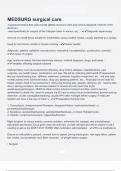STUVIA 2024/2025
MEDSURG surgical care
-surgical procedure that uses a small lighted camera to view and remove diseased contents of the
abdomen
-used specifically for surgery of the Fallopian tubes in women, etc... - ✔✔Diagnostic laparoscopy
removal of a small tissue sample for examination using a hollow needle, usually attached to a syringe
Used for liver biopsy usually or maybe a kidney - ✔✔biopsy needle
diagnostic, ablative, palliative, reconstructive, restorative, transplantation, constructive, cosmetic -
✔✔purpose of surgery
Age, nutritional status, fluid and electrolyte balance, medical diagnosis, drugs, and habits -
✔✔Variables affecting surgical outcome
medical history such as acute/chronic illnesses, drug history, allergies, hospitalizations, past
surgeries, any health issues, medications, and age. We will be collecting data based off assessment
like any vision/hearing loss, stiffness, weakness, paralysis, cognitive impairment, etc... will also note
normal activity level, nutritional status, drug use, sleeping patterns, etc... Physically we will note VS,
%
height, weight, head to toe assessment, noting any hearing aids, glasses, dentures, etc.. hearing aids
stay in during procedure. We will also assess for anxiety and will report this to the
anesthesiologist/surgeon. NEED to obtain written informed consent and they need to be fully
awake/alert to obtain this. Need to prepare the GI tract to reduce fecal contamination, prevent post-op
distention, avoids constipation/straining, usually NPO after midnight before surgery, if meds are
needed can have a few sips of water o - ✔✔Preoperative Nursing Care
1. Tranquilizers: chlorpromazine/Thorazine, diazepam/Valium, hydroxyzine/vistaril, or
promethazine/phenergan.
2. Sedatives: secobarbital/Seconal, pentobarbital/Nembutal, or choral Hydrate/noctec
3. Opioids: morphine/duramorph, meperidine/Demerol
Might be given to reduce anxiety, promote sedation, antiemetic (for nausea), and anticholinergic
(decreases secretions). Once given raise the side rails, provide call light and inform patient to call if
needing to get up but MUST STAY IN BED after medication administration. - ✔✔Pre-op medications
Ensure no nail polish is present, consent form is signed, pre-op meds given, vital signs taken, patient
has voided, and prosthesis have been removed. - ✔✔right before surgery
• Surgeon
stuvia
, STUVIA 2024/2025
- assistant surgeon
• first Surgical assistant (RN)
• Anesthesiologist/CRNA
• Scrub nurse/tech
• Circulating nurse (RN) - ✔✔The surgical team
- Respiratory complications/hypoxia: inadequate oxygen to blood tissues
- shock: due to anesthesia/loss of blood
- conscious sedation:
- malignant hyperthermia: body Temp lower than normal - ✔✔Anesthesia complications
The dermal layer of the skin is the middle section which helps by protecting the underlying structures
from injury and also assist with wound healing. This layer has collagen and elastin fibers which help
provide strength and elasticity which helps protect the skin integrity. When these are depleted due to
aging or other factors, the patient is at greater risk for impaired skin integrity. - ✔✔The dermis
The skin plays an important role in the production of vitamin A and D. The skin also protects against
bacteria and viruses. Also the skin helps regulate the body temperature. - ✔✔A nurse is teaching a
group of older adults about skin functions, what should they include?
%
regulate body temperature, eliminate wastes, protects against trauma, radiation from the sun, toxins,
and microorganisms. It also gives sensory perception and controls fluid loss. - ✔✔The skin helps
- give legal permission for surgery and has 2 purposes
- valid for 30 days after signing
- surgeon must explain in terms to patient understands about the diagnosis
- consent must be signed before analgesics or sedatives are given
- consent must be given voluntarily
- nurses only witness persons signature of consent
- ONLY the surgeon can answer questions in regards to the surgery we can NOT. Part of informed
consent. - ✔✔Preoperative Consent
This is where we identify the patient with two identifiers, talk about known allergies, talk about the
surgery occurring today, etc... this for patient safety. - ✔✔Time out period in surgery
Assess respiration frequently to ensure the patient is recovering from medication accurately. Be
prepared to administer antidote if patient is not recovering properly. Usually naloxone/narcan or
flumazenil. Check wound dressing. Vital signs also need to be monitored every 5-15 minutes
according policy. Patient needs to be NPO/nothing by mouth until the gag reflex returns in order to
protect the airway. Important to prevent hypothermia so provide lots of warm blankets, etc... assess
stuvia




